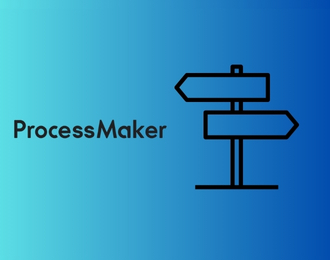Insurance teams face increasing pressure to enhance operational efficiency, maintain regulatory compliance, and meet growing customer expectations.
Relying on outdated processes or disconnected systems can result in errors, delays, and compliance risks. To stay competitive, insurers must adopt advanced insurance policy management software that enables straight-through processing, automation, and improved customer experience.
A robust policy administration system streamlines the entire policy lifecycle, enhancing policy servicing, claims management, and billing, driving business growth, and providing a competitive advantage.
With the global policy management software market expected to reach $2.18 billion in 2025, let us explore the 10 best insurance policy management solutions for your business needs.
What is Policy Management in Insurance?

Policy management software in the insurance streamlines operations
Policy management in insurance refers to the complete lifecycle of managing an insurance policy, from issuance to expiration or cancellation. This includes tasks such as quoting, underwriting, policy issuance, renewals, endorsements, claims processing, and reporting.
An efficient policy management system automates and integrates these processes, improving accuracy, reducing manual work, and ensuring compliance with regulatory requirements.
By streamlining operations, the policy administration software enhances operational efficiency, accelerates decision-making, and provides a seamless experience for both insurance providers and policyholders.
Key Capabilities of Insurance Policy Management Software
 Key capabilities to look for in the top software for insurance policy management
Key capabilities to look for in the top software for insurance policy management
Here are the 6 key capabilities that can transform your insurance business:
1. End-to-end policy lifecycle management
The software should automate every stage of the policy lifecycle, from quoting and underwriting to claims and renewals. This ensures a seamless experience for both customers and insurance teams, improving policy servicing and customer engagement.
2. Automated document generation
Look for a solution that automatically creates and distributes policy documents, claims forms, renewal notices, and contracts. This reduces manual effort, speeds up processing times, and ensures documents are compliant with regulatory standards.
3. Compliance tracking
A robust platform should have built-in compliance tracking, enabling organizations to meet industry regulations like GDPR, Solvency II, and DORA. These regulations govern how insurers handle personal data, ensure financial solvency, and manage claims processing.
With real-time auditing and continuous monitoring, insurers can ensure all processes adhere to regulatory standards and operate from a single source of truth.
 FlowForma’s compliance USPs
FlowForma’s compliance USPs
4. Claims management workflows
The tool you choose should automate claims processing, improving turnaround times and reducing errors. With streamlined workflows, insurers can ensure claims are handled quickly and accurately, while staying in line with internal policies and industry regulations.
5. Multi-channel policyholder engagement
Ensure the platform offers tools to provide real-time updates to customers via automated emails, SMS, or self-service portals. This enhances the customer experience, allowing clients to access their policy information at any time, thereby increasing satisfaction and engagement.
6. Advanced reporting and analytics
The software should offer real-time data insights that help insurers make better, informed decisions. With built-in reporting capabilities, businesses can track policy performance, claims trends, and other key metrics, driving improvements in operational efficiency.
Top insurance policy management software in 2025
Let us take a quick look at the 10 best insurance policy management tools before we explore each product in detail.
|
Tool |
Best For |
Key Capabilities |
|
FlowForma |
End-to-end policy management in regulated environments |
No-code workflow builder, AI Copilot for process creation, automated document generation |
|
Sapiens |
Enterprise insurers needing end-to-end policy administration |
Comprehensive policy, billing, and claims integration, full compliance support |
|
Guidewire |
Large insurers require policy, rating, and underwriting integration |
Policy management, rating engine, and underwriting workflows |
|
Applied Epic |
Brokers and agencies seeking cloud-based policy lifecycle management |
Cloud-based policy management, CRM integration, customizable workflows |
|
Nintex |
High-volume document automation in policy workflows |
Workflow automation, document generation, RPA connectors |
|
Power Apps + Automate |
Microsoft-first insurers with IT-led development |
Microsoft ecosystem integration, custom app development, workflow automation |
|
Origami Risk |
Commercial and specialty insurers needing policy + claims integration |
Claims and policy management, real-time reporting |
|
Insly |
MGAs and small insurers seeking digital policy administration |
Digital policy administration, cloud-based solution, easy to implement |
|
NowCerts |
Independent agencies handling client policy tracking and renewals |
Policy tracking, renewal automation, and client relationship management |
|
BriteCore |
Mutual insurers and MGAs seeking an all-in-one policy solution |
End-to-end policy administration, billing, and claims management |
Top Insurance Policy Management Software in 2025
Let us explore the key features, pros, and cons of the ten tools that are taking the insurance industry by storm:
1. FlowForma

FlowForma insurance playground
FlowForma is an AI-powered business process automation platform that enables insurers to quickly automate the entire policy lifecycle, from creation to claims management, all without the need for IT involvement.
The platform is ideal for regulated mid and large-sized industries where compliance and efficiency are critical.
FlowForma Key Features
1. No-code workflow builder
FlowForma’s no-code workflow builder empowers business users to automate complex insurance workflows without needing IT skills or coding expertise.
This intuitive tool enables organizations to design, deploy, and manage policy lifecycles and other critical insurance processes in a fraction of the time, allowing for faster responses to changing business needs.
 FlowForma’s no-code process automation tool Vs Low Code
FlowForma’s no-code process automation tool Vs Low Code
2. Advanced AI Features
FlowForma’s AI Copilot is designed to assist users in building structured workflows by interpreting natural language instructions. For example, watch this demo to see how an insurance renewal workflow can be built using AI Copilot.
Additionally, Agentic AI integrates intelligent automation into the policy workflow. It analyzes real-time data and applies predefined rules to automate decision-making processes, such as policy approvals or claims assessments, thereby improving accuracy and efficiency.
⭐Pro Tip: Watch the AI-powered insurance automation masterclass to learn more.
For deeper process optimization, FlowForma offers the Discovery Agent, which identifies automation opportunities and generates suggestions for process improvement.
3. Automated document generation
With FlowForma, businesses can automate the creation of documents like policy contracts, claims forms, and renewal notices.
By extracting data from completed workflows, FlowForma ensures that all documents are consistently formatted, compliant, and automatically sent to the relevant stakeholders, reducing manual errors and administrative workload.

Benefits of FlowForma’s document generation feature
4. Microsoft 365 integration
FlowForma seamlessly integrates with Microsoft 365, enabling easy collaboration within tools like SharePoint Online. This ensures seamless communication, document sharing, and task management without the need to switch between platforms.
5. Data security
FlowForma hosts client data within their own SharePoint tenancy, offering insurers full control over their data. This setup ensures that sensitive policyholder information remains secure and compliant with regulatory requirements, as organizations retain ownership of their data while benefiting from FlowForma’s robust security measures.
FlowForma Pros
- 10x faster automation than traditional low-code platforms
- Eliminates the need for IT involvement, empowering business users to create and manage workflows
- Built-in compliance tracking ensures that policies meet regulatory standards
- Form and document automation features
- Transparent, process-based pricing with no hidden fees
FlowForma Cons
- Best suited for companies using Microsoft 365
FlowForma Pricing
FlowForma’s pricing is tiered and process-based. There are no hidden fees, making it a transparent and cost-effective solution for mid-sized and large businesses. See the complete pricing breakdown information here.
💡Real-world example: How Aon streamlined its insurance operations using FlowForma
Aon, a leading insurance giant, faced challenges with manual, paper-based processes that slowed policy approvals, created bottlenecks, and increased the risk of errors across its insurance operations.

Aon achieved accurate policy management across the organization using FlowForma
💡Watch the customer success video featuring Aon here.
By implementing FlowForma, the company was able to digitize and automate key workflows, including policy issuance, approvals, and renewals. This transformation delivered faster turnaround times, improved compliance tracking, and enhanced operational efficiency.
|
“We didn’t have to go off and buy infrastructure; we could pretty much slot it into the systems we had but it gave us much greater control. Customization within FlowForma Process Automation is far better than anything we have had previously. It gives us a platform to help the business make their jobs easier and my job easier.” - Robbie Molloy, Aon’s Product Manager |
2. Sapiens
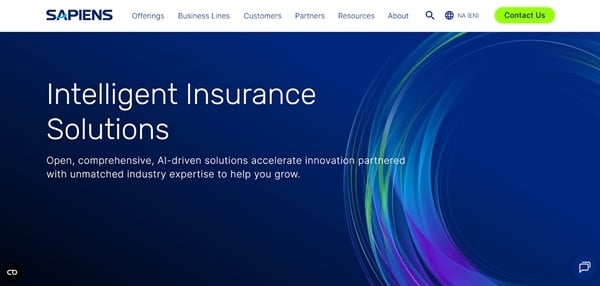
Sapiens homepage
Sapiens is an integrated platform for large insurers looking to automate and manage the entire policy lifecycle, from policy issuance and billing to claims and renewals.
This enterprise-grade solution offers features for multi-line insurance businesses, including in-depth reporting and regulatory compliance.
Sapiens Key Features
- Regulatory compliance support through pre-configured tools
- Advanced reporting and analytics that provide detailed insights into policy performance, claims processing, and operational efficiency
- Customizable configuration options that allow for the tailoring of policies, workflows, and user interfaces
- Integration with third-party tools for seamless data exchange
- Cloud-based deployment that ensures scalability
Sapiens Pros
- Suitable for large-scale insurers with complex needs
- Strong regulatory compliance tools
- Powerful reporting and analytics capabilities
- Robust multi-line policy management support
- Extensive integration options with third-party tools
Sapiens Cons
- High total cost of ownership
- Long implementation timelines
3. Guidewire

Guidewire Homepage
Guidewire offers a fully integrated system for large insurers needing to manage policy administration alongside underwriting and rating workflows.
Ideal for insurers handling complex policies across multiple lines of business, it provides the flexibility and scale required by large enterprises, but with a relatively steep learning curve and significant cost.
Guidewire Key Features
- End-to-end policy management that integrates policy creation, rating, and underwriting processes
- Rating engine integration allows for complex policy pricing and underwriting workflows
- Multi-line policy management to support policies across various business lines
- Real-time analytics for insights into policy performance, underwriting decisions, and claims processing
Guidewire Pros
- Scalable for large enterprises with complex workflows
- Broad integration capabilities with other Guidewire tools
- Supports multi-line policy management for diverse business needs
- Powerful analytics for real-time decision-making
- Strong regulatory compliance features
Guidewire Cons
- High cost of implementation and maintenance
- Complex setup and steep learning curve
4. Applied Epic

Applied Epic Homepage
Applied Epic offers an intuitive, cloud-native platform that enables brokers and agencies to manage the entire policy lifecycle.
It supports businesses seeking to simplify policy administration, renewals, and claims management without dealing with the complexities of large-scale enterprise systems.
Applied Epic Key Features
- Cloud-native policy management that ensures accessibility from anywhere
- CRM integration that connects policy data with customer relationship management tools
- Policy administration and renewal automation
- Security and data protection through cloud-based security measures
Applied Epic Pros
- Cloud-based with mobile access for flexibility
- Simple user interface for quick adoption and minimal training
- Strong CRM integration for customer management
- Automated renewals and policy management
- Affordable for mid-sized agencies
Applied Epic Cons
- Limited scalability for large enterprises
- Fewer AI-powered tools for underwriting and claims management
5. Nintex

Nintex Homepage
Nintex supports document-heavy workflows, automating document generation, approval, and distribution in policy processes.
Ideal for insurers dealing with high volumes of policies and claims, it simplifies workflows with its RPA connectors and workflow automation capabilities. However, it’s not a complete policy management solution, so it works best when integrated with other tools.
Nintex Key Features
- Workflow automation that integrates document creation and distribution into policy workflows
- Robotic Process Automation (RPA) that automates repetitive tasks such as approvals, data entry, and notifications
- Compliance management to ensure all automated processes meet regulatory requirements
- Cloud-based deployment for scalability and remote access
Nintex Pros
- Supports document-heavy workflows in policy processes
- Workflow automation and RPA integration
- Easily integrates with existing systems
- Streamlines approval processes and reduces manual effort
- High compliance support
Nintex Cons
- Not a complete policy lifecycle solution
- Requires external tools for advanced claims management
6. Power Apps + Automate
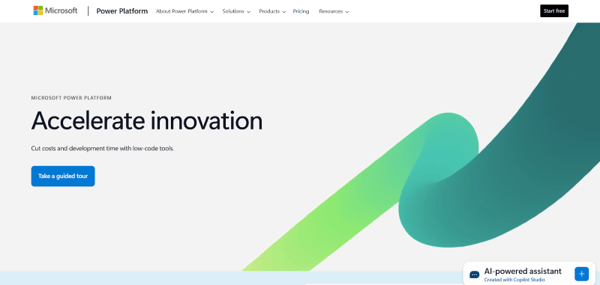
Power Platform page
Power Apps and Power Automate provide a flexible solution for insurers already embedded within the Microsoft ecosystem. These tools allow for the creation of custom apps and workflows, although they require some IT expertise for setup.
While they’re great for developing highly specific workflows, they may not offer the out-of-the-box features insurers need for full policy lifecycle management.
Power Platform Key Features
- Custom app development for personalized application building
- Microsoft ecosystem integration to easily connect with other Microsoft tools
- Automated workflows that streamline policy approvals, claims, and renewals
- Data security with enterprise-grade protection
- Cloud and on-premises deployment options based on the organization’s needs
Power Platform Pros
- Seamless integration with Microsoft tools
- Custom app development and workflow automation
- Advanced security features from Microsoft
- Flexible deployment options
- Ideal for IT-led development
Power Platform Cons
- Requires coding skills and technical expertise
- May incur hidden IT costs for ongoing maintenance and development
7. Origami Risk
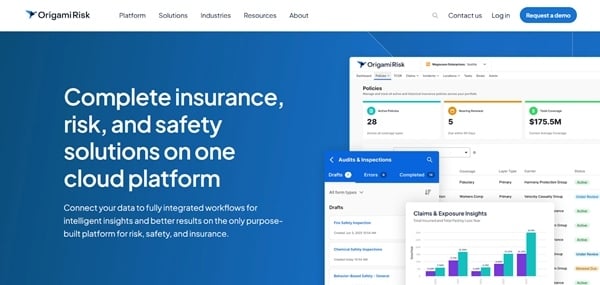
Origami Risk homepage
Origami Risk supports commercial and specialty insurers needing to integrate policy management with claims processing.
It provides real-time data on policy performance and claims trends, enabling insurers to effectively manage risk while enhancing operational efficiency.
Its cloud-native platform makes it scalable for larger insurers, though it can be costly for smaller businesses.
Origami Risk Key Features
- Policy and claims integration in one platform
- Risk management tools to identify and manage risks across policies and claims
- Regulatory compliance support to meet industry standards
- Customizable workflows to align with an insurer’s unique needs
- Cloud-based scalability that grows with your business
Origami Risk Pros
- Strong claims management integration with policy workflows
- Real-time policy and claims reporting
- Customizable workflows for tailored solutions
- Comprehensive compliance features
- Scalable for large enterprises
Origami Risk Cons
- Expensive for small insurers
- Complex onboarding and training
8. Insly
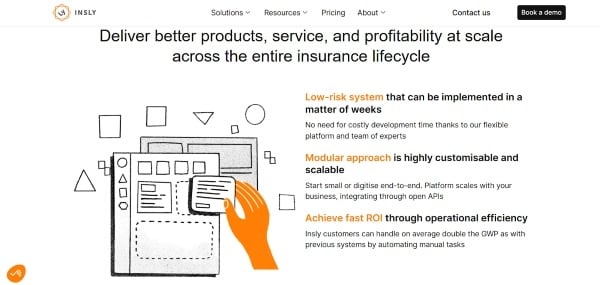
Insly’s homepage
Insly is designed for managing general agents (MGAs) and small insurers seeking an affordable, user-friendly solution to manage policies, renewals, and claims.
With its cloud-native platform, Insly offers a streamlined experience for small businesses that need to stay competitive without overcomplicating their processes.
Insly Key Features
- Cloud-based policy administration that simplifies policy management
- Easy implementation with quick setup for small businesses
- Integration capabilities to connect with other tools and enhance data flow
Insly Pros
- Affordable solution for small to mid-sized insurers
- Cloud-based with simple implementation
- User-friendly interface for quick adoption
- Automated renewals and policy management
- Scalable as the business grows
Insly Cons
- Limited features for enterprise-level insurers
- Basic reporting capabilities
9. NowCerts

NowCerts Homepage
NowCerts is a straightforward tool that helps independent insurance agencies track policies and manage renewals.
It’s a user-friendly platform that automates key aspects of client relationship management, making it a good choice for agencies looking to streamline operations without a steep learning curve.
NowCerts Key Features
- Automates policy tracking and renewal features for agencies
- Client management tools to manage and track interactions with clients
- Cloud-based platform for flexibility and remote access
- Simple integration with other business tools like CRM systems
- Document generation for automatic creation of policy contracts and claims forms
NowCerts Pros
- Simple to use, with a low learning curve
- Affordable for small agencies
- Automates renewals and policy tracking
- Cloud-based and easily accessible
NowCerts Cons
- Limited scalability for larger organizations
- Lacks some advanced automation features
10. BriteCore

BriteCore Homepage
BriteCore is an all-in-one policy management solution designed for mutual insurers and MGAs.
It offers capabilities for policy administration, billing, and claims management, making it an ideal solution for insurers looking for a flexible, scalable platform that grows with their needs.
BriteCore Key Features
- Billing and claims management to streamline all aspects of policy lifecycle management
- Cloud-based deployment that offers scalability and remote access
- Customizable workflows to suit the unique needs of insurers
- Modular solution that allows insurers to add or adjust capabilities as their needs evolve
- Flexible data integration with other systems
BriteCore Pros
- Affordable for mutual insurers and MGAs
- All-in-one solution for policy, billing, and claims management
- Scalable and cloud-native for growing businesses
- Highly customizable workflows
- Modular deployment for flexibility in scaling
BriteCore Cons
- Implementation complexity
- Limited advanced automation compared to larger enterprise systems
Why FlowForma is the best insurance policy management software
 Snapshot of Aon testimonial
Snapshot of Aon testimonial
FlowForma stands out as the ideal solution for insurance policy management, offering a no-code platform that empowers business users to automate the entire policy lifecycle with ease.
Its seamless integration with Microsoft 365, combined with built-in compliance tracking and AI-powered workflows, makes it a powerful tool for insurers aiming to enhance operational efficiency, ensure compliance, and improve customer experience.
With transparent pricing and rapid implementation, FlowForma provides unmatched value for insurers in regulated industries. Ready to experience it for yourself? Book a demo with FlowForma today,
.png) By
By 

